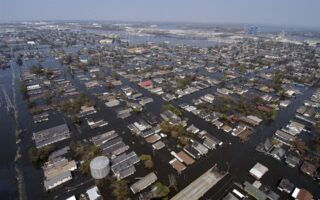[ad_1]
This year’s terrifying “winter wave” looks different.

Glittering trees and festive displays in store windows mean two things: The holidays have arrived. And so is Covid. Since the beginning of the outbreak The week between Christmas and New Year also falls on The terrifying “winter wave” In that dark time case have reliably more After increasing throughout the fall The 2020 and 2021 holiday seasons were two of the most severe COVID outbreaks to date. Infections have skyrocketed, leading to hospital admissions and death.
But something strange happened this year. From September to November Virus level in wastewater, which is one of the most reliable indicators at the moment. At this time, patient cases cannot be tracked any longer. and had unusually low values at various points throughout that period. Hospital admission and deceased It’s also near an all-time low.
That doesn’t mean we’ll have a COVID-free Christmas, CDC data released over the past two weeks shows. Viral activity in wastewater increases rapidly.– Whether this is the start of a winter wave remains unclear. But even if it were like that Yet time is still off. Last year, the winter wave came close to peaking around Christmas. This time, this wave (if there is one) is only just beginning. America is in for the most unpredictable COVID holiday season yet.
The optimistic view is that the increase in wastewater levels reflects the spread that occurred during the Thanksgiving holiday. And it will decline rapidly, said Michael Hoerger, a professor at Tulane University who runs the Pandemic Mitigation Collaborative. which is the COVID forecast dashboard tells me This is likely because the CDC posts wastewater data approximately one week after collection. The latest data represents two weeks after the holiday. This gives people who were infected during the break time to develop symptoms. The worst case scenario is that low transmission throughout the fall is a windfall. And in the next few weeks The virus is quickly catching up, and Hoerger expects transmission to continue to increase over the next few weeks. And it could peak around Jan. 7, although a clear increase or decrease is still “possible,” he said. Even though a surge is around the corner, “it probably won’t be anywhere near any peak. that we have during the pandemic.” Michael Osterholm says an epidemiologist from the University of Minnesota.
Confusion about how the virus behaves during the holidays reflects larger COVID uncertainties: Even after four consecutive winter waves, Yet experts are hesitant about whether we should continue to hope. Caitlin Rivers, an epidemiologist at Johns Hopkins, told me it would be “very unusual” if there were no waves. This is because the virus generally follows a reliable pattern of peaks in summer and winter. But Osterholm rejects the idea that the virus follows a predictable pattern. The nine peaks that have occurred since COVID emerged “It’s not predicted at all seasonally,” he said. Winter waves are less relevant. winterThat and more has to do with the unpredictable emergence of new variants, which is superimposed on waning immunity, Osterholm said.
Arguing that COVID doesn’t follow a seasonal pattern and has a recent history of ruining the holidays isn’t easy. Part of the confusion stems from the expectation that viruses should behave like other respiratory bugs, including the flu and respiratory syncytial virus, or RSV, which tend to spike in the winter. Which is why vaccinations are offered in the fall. But as my colleague Katherine J. Wu writes, SARS-CoV-2 is not a common respiratory virus. This is despite the fact that, as expected, updated COVID vaccines are recommended ahead of the winter virus season. influenza and RSV This moment is increasing. In a sense, it’s a strange time. This year’s Covid situation is considered a coincidence. Because it means “Peak season may not align with influenza,” Rivers said. Help reduce the burden on the hospital.
After living with this virus for nearly five years. You might expect that its behavior would be more predictable. But in scientific terms Five years is not a long time. COVID can get worse every winter. But it’s too early to tell. “The only thing that makes this virus seasonal is that it happens every season,” Osterholm said. Any patterns that emerge over time may become obsolete as more data is gathered. As time passes Ups and downs that are interpreted as trends may prove to be abnormal in an entirely different way. That’s “funky,” such as having two small waves and one big wave each year, Hoerger said.
try your best Covid prediction is a guessing game at best. When the holidays are approaching Today’s reality offers both warning and reason for hope. A new wave may be upon us, but things seem unlikely to unfold in the same way they have in years past. As the virus surges during what should be the most festive time of the year. This is not a Covid-free Christmas. But it is still something to be thankful for.
[ad_2]
Source link



